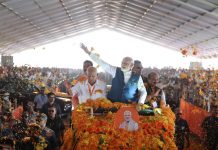 With just two months to go for the state assembly polls in West Bengal, battlelines have already been drawn between the major political parties with hectic electoral preparations having been underway for the past over two months. Apart from the ruling Trinamool Congress (TMC) led by Mamata Banerjee, the BJP is seemingly the major challenger to the TMC. Undeniably, the Left parties and Congress have few pockets of influence in the state; nonetheless, they are not major players. Media reports indicate that Janata Dal (United) or JD (U) along with Rashtriya Janata Dal (RJD) from the neighbouring state of Bihar are also eager to test the electoral waters of Bengal politics.
With just two months to go for the state assembly polls in West Bengal, battlelines have already been drawn between the major political parties with hectic electoral preparations having been underway for the past over two months. Apart from the ruling Trinamool Congress (TMC) led by Mamata Banerjee, the BJP is seemingly the major challenger to the TMC. Undeniably, the Left parties and Congress have few pockets of influence in the state; nonetheless, they are not major players. Media reports indicate that Janata Dal (United) or JD (U) along with Rashtriya Janata Dal (RJD) from the neighbouring state of Bihar are also eager to test the electoral waters of Bengal politics.
Muslims, constituting about 30 per cent of the total population of the state, are said to be a deciding factor in nearly 100-110 seats in the state and the entry of AIMIM in the state politics has been dubbed by the TMC leaders as an attempt to split the Muslim vote in the state and help the BJP. During the 2019 Lok Sabha elections, the Muslims acted as a bulwark of the TMC against its rivals, with most of them voting in favour of the TMC, considering it as a credible force that could resist the saffron surge. However, the decision of Pirzada Abbas Siddiqui of Hooghly district’s Furfura Sharif, an influential cleric, to float his new political outfit — Indian Secular Front — and his plans to contest the elections from all 294 assembly seats, entails the potential of upsetting many political equations in the poll-bound state.
BJP’s game plan
Buoyed by its tally in West Bengal in the 2019 Lok Sabha elections, the BJP’s Amit Shah has taken on himself to wrest West Bengal from TMC and for this purpose he along with other senior BJP leaders embarked on a strategy of organizing rallies, inducting ‘disgruntled’ TMC leaders into the BJP, raising the CAA issue to polarize the Hindu votes and promising a sonar Bangla. The BJP’s known stance on CAA and the minorities, especially the illegal immigrants, is, on the one hand, bound to create insecurities among the minorities, and on the other hand, polarizing the Hindu vote. Undeniably, the BJP’s claim to the legacy of Shyama Prasad Mookerjee can be an asset for the party; concurrently, it is a long way to go for the party to rebut the charge of TMC that the BJP is a party of outsiders because most of the influential leaders inducted into the BJP are not original party members but migrants from other parties like Left Front and TMC.
There is no exaggeration in saying that the BJP has taken a quantum leap in West Bengal since 2019 Lok Sabha elections, from a count of two seats out of 42 in 2014 to 18 seats in 2019. According to some experts, the BJP’s vote share did not decline between 2014 and 2019 in any parliamentary constituency, while Left front’s share declined in every parliamentary constituency. The Left’s loss was the BJP’s gain because the Left vote share did not transfer to the TMC. Broadly speaking, the Left cadre and supporters voted ‘strategically’ for the BJP to defeat the TMC. The post-2019 period has witnessed defections from the Left as well as the TMC. Nevertheless, a major component of the game plan of the BJP has been to spirit away key aides, ministers, MPs and MLAs of Mamata-led TMC to deflate her morale and enfeeble the TMC.
According to reports in a section of media, the BJP has made efforts to appropriate the legacy of Netaji Subhash Chandra Bose to its electoral advantage in the poll-bound state of West Bengal by organizing a meeting at Victoria Memorial at Kolkata on January 23 to commemorate the 125th birth anniversary of Netajiin the presence of Prime Minister Narendra Modi. While addressing the gathering, Chief Minister Mamata Banerjee objected to the chants of Jai Shri Ram, in the presence of Prime Minister and left the podium as a mark of protest. One expert has pointed out that the TMC supremo was expressing her anguish at a slogan that has acquired a political hue and riled her earlier and at another level she was objecting to at the BJP’s attempts at owning Netaji. Some observers feel that the BJP’s attempts to appropriate the legacy of Netaji is fraught with ideological contradictions because, if anything else, Netaji was avowedly secular through his political career.
Mamata’s defensive offence
Despite desertion of some leaders from the TMC to the saffron brigade, the TMC leadership is still confident of coming with flying colours in the ensuing state assembly polls. Though exit of leaders in the run up to the elections is not a surprising development for a regional political party like TMC; nevertheless, when it is faced with a national party like the BJP, the ensuing electoral battle becomes more competitive for the TMC leadership for not only to ensure its victory but also to control the damage it could incur by being defensively offensive. The BJP winning of 18 Lok Sabha seats in 2019 translates into 121 assembly segments and in order to realize Amit Shah’s estimate of 200 seats, the BJP will have to significantly improve its numbers.
Nevertheless, the TMC takes comfort in the fact that tone and tenor of Lok Sabha polls is usually different from the assembly elections and its leadership is confident that TMC fort is not going to crumble. Recent desertions within the TMC demonstrate how ill-quipped the TMC is in handling and addressing internal dissent and how centralized power within the party is. The TMC, according to some experts, suffers from a structural flaw primarily because it revolves around the personality of one leader. Admittedly, the TMC had a movement character to it in the initial stage that enabled the party to successfully dislodge the electoral hegemony of the CPI (M) that had lasted for over three decades; nonetheless, the TMC continued to maintain total dominance at the ground level by inducting local leaders and cadres from other parties but failed to carve itself into a party. Allegiance to the leader held the party together and the loyalty was bought by offering patronage.
Some experts also attribute the delay on the part of the senior TMC leadership in addressing the concerns of the party rank and file as being responsible for mass exodus of leaders from the party to the saffron fold and emphasize that the TMC needs to introspect and dispel all doubts about its inclusive character. Recent assertions of Mamata Banerjee reflect her confidence that her government of ‘Ma-Mati-Manush’ will retain power in the state. She has described BJP as a balloon that is alive only in media, whereas the TMC stays alive in the hearts of the people.
Way forward
The ensuing state assembly elections will witness very interesting polls in West Bengal. While proving to be a litmus test for the policies of the TMC government as well as for the leadership of the TMC supremo, it is also going to be a test of the BJP central leadership in the wake of ongoing farmers agitation in many parts of the Hindi heartland.
As Prashant Kishor, the poll strategist for the TMC, has predicted that the BJP may not cross the 100-seat target as against Amit Shah’s claim of securing 200-seats, it is to be seen as to who proves to be right. Keeping in view the fact that West Bengal has a history of poll violence, it would be in the fitness of things that if political parties do well to desist from pandering to parochial sentiments and insist instead on a blueprint for the economic development of the state.
letters@tehelka.com













